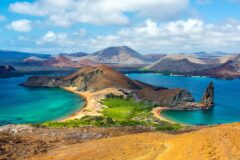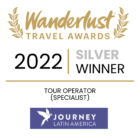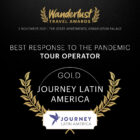Private Journeys
Off the beaten track Brazil: Dunes and lagoons of Lencois Maranhenses
10 days
from £2,700pp

Overview & Highlights
Head to the far north of Brazil to discover historic Olinda, the remote sand dunes and lagoons in Lencois Maranhenses National Park and the historic port of São Luis.
- Olinda: guided walking tour
- São Luis: guided walking tour
- Lençois Maranhenses: 4WD excursions in the far north
Lencois Maranhenses tours will have you constantly reaching for your camera. This journey explores the surreal, sandy dunes of Brazil’s far northeast and visits two Unesco-listed colonial gems.
Fly into the dynamic port Recife, with its history of slaving, now renewed as a capital of the arts, supremely of music and dance. Start your holiday in the nearby centuries-old town Olinda, with divine Portuguese architecture lining cobbled streets.
Travel on to the remote far north of Brazil and the huge Parnaíba delta. Its islets and lagoons are fabulous bird watching destinations. Beyond, are the surreal dunes and crystalline pools of Lençois Maranhenses National Park. A traditional way of life survives in the region’s sleepy, riverine fishing communities and small coastal towns. Even the popular beach hangout of Jericoacoara remains low-key. This is an adventurous trip taking you exploring by jeep, boat and 4WD.
Outline itinerary
Day 1
Arrive Recife and transfer to hotel in Olinda
Day 2
Walking tour of Olinda.
Day 3
Transfer back to Recife airport and fly to São Luis.
Day 4
By road to Atins in Lençois Maranhenses.
Day 5
Explore Lencois Maranhenses National Park.
Day 6
By road to Parnaíba on a river delta.
Day 7
By road to Jericoacoara, a laid back village on the Atlantic coast.
Day 8-9
At leisure among the dunes.
Day 10
Transfer to Fortaleza airport.
Itinerary
Day 1
Arrive Recife and transfer to hotel in Olinda
Meet your driver/guide at Recife airport (it’s possible to fly directly from Europe to the northeast of Brazil). This pulsating city, whose status as a crumbling, neglected colonial slaving port is being transformed as it benefits from a face-lift and burgeoning arts scene, sits on three small islands connected with each other and the mainland by over two dozen bridges.
Transfer to your hotel in the much more tranquil town Olinda, like Recife founded by the Dutch but now a glorious example of Portuguese architectural flair. A maze of steeply cobbled streets, pastel coloured houses, baroque fountains and elegant squares blankets the hills. But it’s not always a sleepy place: Olinda is renowned for its wild and raucous Carnival.

Day 2
Walking tour of Olinda.
Take to the streets to discover more intimately the beautiful nooks and crannies of this beautiful UNESCO listed town on foot. Your guide will introduce you to some of the country’s quaintest baroque churches, as well as to state-approved graffiti murals which adorn Olinda’s walls. Many of the towns buildings have a fascinating history, such as the San Bento Monastery which was the site of the country’s first law school and the first place to abolish slavery. Climb up to the Igreja da Se church topping a hill from which are sweeping views over the town and palm-defined coastline.

Day 3
Transfer back to Recife airport and fly to São Luis.
São Luis is the capital of Maranhão, a port on Brazil’s north coast at the junction of two rivers and the sea . It has a multifaceted history: founded by the French but constructed by the Portuguese as an entry point for African and Amazonian slaves, nowadays it is a bit of a scruffy backwater but with pockets of undeniably photogenic charm, its crumbling façades redeemed by the presence of dazzling bright blue Portuguese tiles, or azulejos.
Flight schedules mean you won’t normally arrive until the late afternoon so there’s usually only time for a brief walking tour around the city’s historic core. Being based at a simple pousada close by, you’ll be able to soak up the city’s atmosphere and appreciate its African heritage, reflected in the music and spiritual rituals – there’s a large Afro-Brazilian element to the population and it can almost seem to be an African city. Many of the colonial façades have been restored, showing off with bright pastel coloured walls. To reinforce this cultural mélange, you can also visit the French-built fort, San Antonio, and the Portuguese cathedral.

Day 4
By road to Atins in Lençois Maranhenses.
Today’s full-day adventure starts with a drive to the bustling little town Barreirinhas, a hub for visitors to the magnificent Lençois Maranhenses National Park. After lunch there, you step into a boat to ride the sluggish waters of aptly named Rio Preguiças (lazy river), fringed by mangroves, which winds its way through a wilderness of sheets of sand and swamps beloved of water birds.
Feel the sand beneath your feet on the golden dunes of ‘Little Lençois’ before it’s back on the river to waterside Mandacaru, a rustic village of squat red-tiled houses lorded over by a lofty lighthouse which offers fantastic views over the park’s far-flung dunes and lagoons. Break the journey again at Caburé, where a handful of thatched fishermen’s huts guarded by a few wind-torn palms are perched on a bar of silky ocean-front sands.
Finally, finish your trip at the remote fishing village Atins, tucked among the dunes, where you’ll spend two nights. The village consists of a stretch of cottages and single storey houses scattered along sand tracks set a short distance back from the beach to protect the inhabitants from the thrust of the winds and the ever changing profile of the sandy coastline. There’s little of tourist infrastructure – no shop, no electricity overnight, and the silence is punctuated by the hissing of the sand whipped up by the breeze. The pace of life here is leisurely to say the least.

Day 5
Explore Lencois Maranhenses National Park.
Explore the Lençois Maranhenses National Park by jeep – you’ll discover an endless expanse of intact sand dunes and clear water lagoons which support a rich variety of wildlife. At first sight you could be forgiven for thinking this was a desert, until the sight of the pools and ribbons of aquamarine water reminds you that the rains accumulate in the folds of the rippling dunes creating a mirage-like effect. The softness of the uniformly pale, cream-to-white sands, devoid of vegetation bar a few tufts of grass, is almost surreal. Water is usually present in the pools between May and September and the views are most spectacular at low sun, when a range of shadows come into play. Just after sunrise is the best time to view this magical phenomenon.

Day 6
By road to Parnaíba on a river delta.
It’s an adventurous 4WD drive across dunes, beaches, swamps and rivers to the Parnaíba delta which you’ll explore by boat. A traditional way of life survives in the communities established among the delta’s islets, mangroves and lagoons, a haven for thousands of birds. In the afternoon you will be taken on a scenic tour by boat within the delta, ending at Canarias Island where you spend the night at a simple lodge in idyllic surroundings.

Day 7
By road to Jericoacoara, a laid back village on the Atlantic coast.
Take a boat back to Parnaíba and then continue by 4WD along the coast, passing virgin-pure wild beaches, cliffs, sand dunes and isolated backwater communities. Arrival in Camocim for lunch before continuing along the beach, passing the village of Tatajuba with its gorgeous lagoon-side setting.
Arrive at the remote settlement of Jericoacoara – dominated by a huge sand dune – which has been voted one of the best beaches in the world. The main streets of ‘Jeri’ are merely broad channels of deep sand flanked by numerous guesthouses, small shops, funky cafés and restaurants. Its origins lie in a laid-back fishing village, nowadays though it is also a hip and popular venue for windsurfing, kitesurfing and exploring by dune buggy. At night there’s a youthful ambience, with lively bars and folksy night clubs.

Day 8-9
At leisure among the dunes.
At leisure in Jericoacoara. If you don’t want to experience one of the sea or dune-borne activities, you can just laze on the beach in front of the Atlantic Ocean, and sip an ice-cool caipirinha at sunset.

Day 10
Transfer to Fortaleza airport.
It’s four hours’ drive to the city of Fortaleza where you will be taken to the airport for your flight home or elsewhere if extending your travels in Brazil.
Essentials
Tour info
Transport
The holiday includes ground transport and domestic air transport starting at Recife airport on day 1 and ending at Fortaleza airport on day 10. Some short stretches are covered by boat.
Accommodation
This holiday uses typical Brazilian pousadas, which are simple but characterful and good quality small hotels or guesthouses. They tend to be rustic in more remote locations but you’ll get a real flavour of Brazil throughout. In Jericoacoara we have selected a charming small hotel built almost entirely of wood and thatch.
Meals
Breakfast daily, lunch days 6,7 dinner days 4, 5
Guides
We carefully select our local partners, some of whom we have worked with for over 25 years. Their English-speaking guides understand the expectations of our clients very well, and are consistently singled out for praise.
Summary Of Nights
10 days, 9 nights: Olinda 2, São Luis 1; Atins 2; Parnaiba 1; Jericoacoara 3
Currency
The unit of currency in Brazil is the ‘real’ (plural reais).
How To Take It
Cash machines are available in all major cities and even small towns, and so taking a debit or credit card with a PIN number is the most convenient way of withdrawing money while on your trip, and in most shops and restaurants you can also pay by card. However, since cards can get lost, damaged, withheld or blocked, you should not rely exclusively on a card to access funds.
We recommend that additionally you take a reasonable quantity of US dollars cash (no more than is covered by your insurance), which you can exchange into local currency. Dollar bills should be in good condition, soiled or torn bills may be refused. You can take sterling, but the exchange rate is not always competitive or even available, restricting the number of places where you can change money.
Daily Spend
A budget of around US$40-70 per day should cover the cost of meals, drinks, local transport, tips and the odd souvenir. Prices of meals and drinks in standard restaurants are more or less the same as in Britain, perhaps a bit cheaper.
Tipping
Tips are welcomed and local guides often rely on their tip as a significant proportion of their income.
Most service industry workers will expect a tip of some kind and so it is useful to have spare change for hotel porters, taxi drivers and the like. It is common to leave 10 – 12% in restaurants.
Insurance
Travel insurance is essential.
Details of our recommended policy can be found on our Travel Insurance page.
Airport Taxes
If you have purchased your flights through Journey Latin America, the international departure tax is usually included in the ticket.
Trip Suitability
There are some long days spent travelling (including a number of internal flights) and the heat can be tiring. The holiday is suitable for all reasonably fit people, including families. If you have a disability requiring special attention please enquire.
Climate
Olinda and São Luís can be visited all year round. The best time to visit Lençóis Maranhenses is May to September – especially June, by which time the rains which fall from January to May are usually over and the lagoons are full of water. By October, the lagoons are usually dry. There’s an almost constant breeze but the sun is very strong.
Clothing And Special Equipment
For day-to-day wear you should take loose-fitting, breathable clothes. Comfortable shoes are important and sandals are useful. A sun hat, sunblock and sunglasses are necessary, and you should take a light fleece for cool nights and a Gore-Tex layer, as well as swimwear, insect repellent and an umbrella or rainproof jacket.
Please get in touch with the office before departure if you have any doubts. Good equipment is very important and hard to come by in South America.
Vaccinations
Preventative vaccinations are recommended against the following; typhoid; polio; tetanus; hepatitis A. For specific requirements you must consult your GP.
As of 2018, visitors to Brazil travelling on our holidays should be protected with a vaccination against yellow fever, and carry the corresponding certificate. In April 2013, the World Health Organisation Strategic Advisory Group of Experts on Immunisation concluded that a single primary dose of yellow fever vaccine is sufficient to confer sustained immunity and lifelong protection against yellow fever disease, and that a booster dose is not needed.
You can also find helpful information on the Masta Travel Health website.
Visas
Holders of a full British passport do not require a visa, although passports must be valid for at least 6 months after the trip begins. Anyone with a different nationality should enquire with us or check with the relevant consulate.
If flying to the US, or via the US you will need to fill in your online ESTA application.
What's included in the price
- Services of our team of experts in our London office
- Services of Journey Latin America local representatives and guides
- All land, river and air transport within Latin America
- Accommodation as specified
- Meals as specified
- Excursions as specified, including entrance fees
Included Excursions
- Olinda: guided walking tour
- São Luis: guided walking tour
- Lençois Maranhenses: 4WD excursions in the far north
What's not included in the price
- International flights to Latin America
- Tips and gratuities
- Meals other than specified
- Airport taxes, when not included in the ticket
- Optional excursions


































